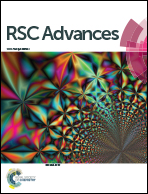Preparation of a functionalized core–shell structured polymer by seeded emulsion polymerization and investigation on toughening poly(butylene terephthalate)
Abstract
Poly(n-butyl acrylate)/poly(methyl methacrylate-co-methacrylic acid) (PBMMA), a core–shell structured modifier with controlled particle sizes, was prepared, and the toughening effects of PBMMA on poly(butylene terephthalate) (PBT) were investigated. The modifier was prepared at a solid content of 50 wt% by a two-stage sequential emulsion polymerization. Dynamic light scattering (DLS) was used to monitor the particle diameters, which showed that the particles grew without significant secondary nucleation occurring. The morphology was confirmed by means of transmission electron microscopy (TEM). According to the results on the mechanical properties of the PBT/PBMMA blends, a remarkable toughening effect of methacrylic acid (MA) on PBT resin was found. By means of scanning electron microscopy (SEM) observation, the toughening mechanism was proposed to be crazing caused by rubber particles and shear yielding of PBT matrix. The uniform dispersion of rubber particles in PBT matrix was attributed to the good compatibility between PBT and PBMMA modifier.


 Please wait while we load your content...
Please wait while we load your content...